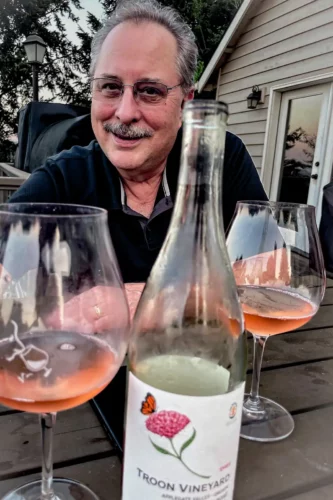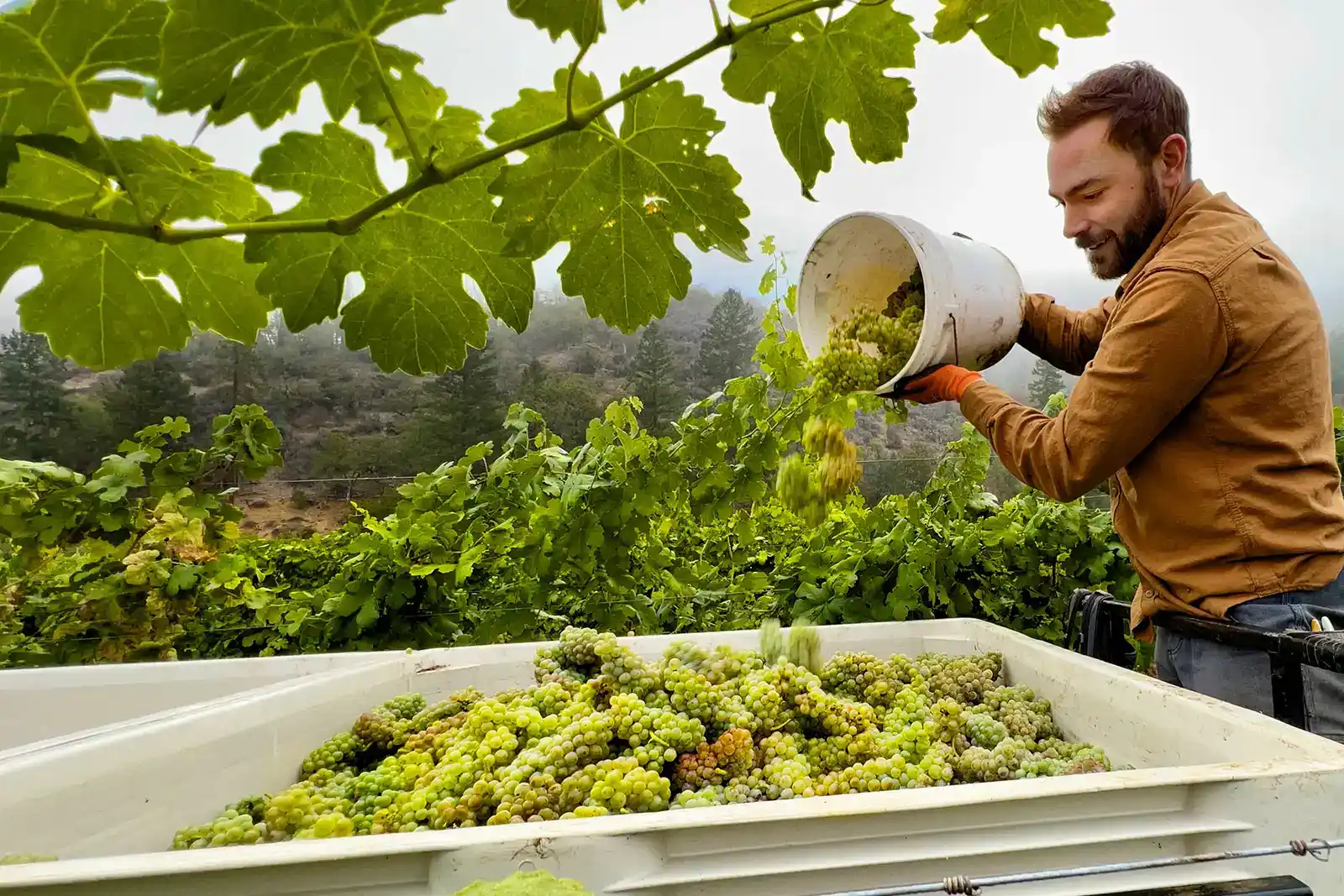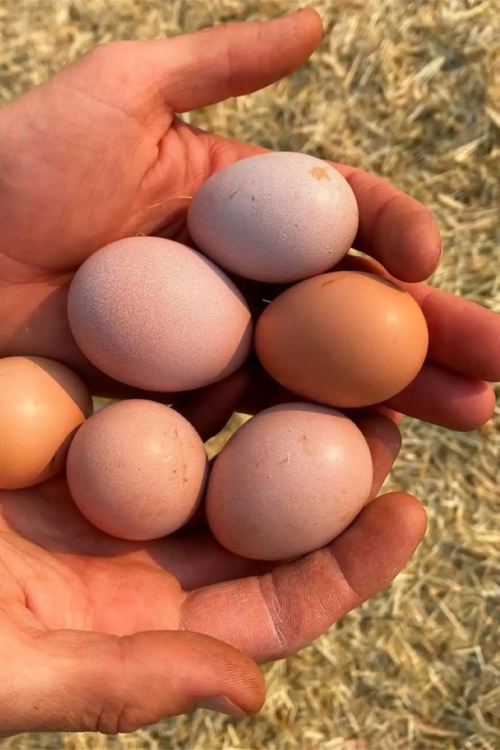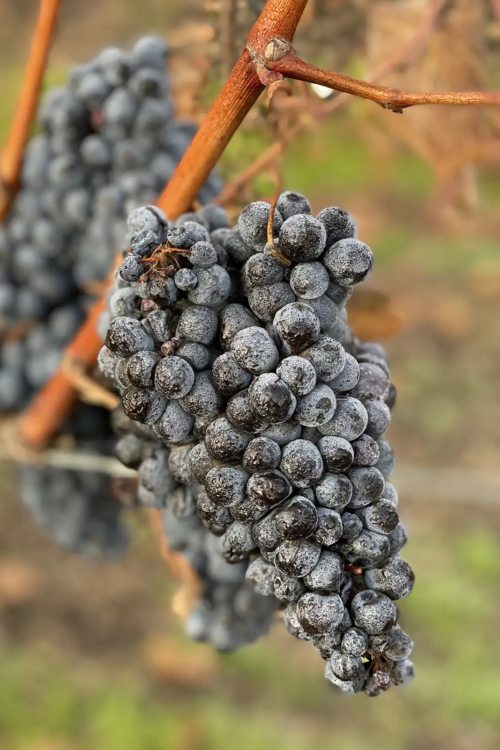“To not exist in a monoculture is always a good thing,” said Craig Camp, the General Manager of Troon Vineyard & Farm in the Applegate Valley of Southern Oregon. We were chatting this past spring about regenerative agriculture and, in particular, the role biodiversity played in the making of his wines.
“There is this classic risk you see [with monoculture]: if a pest is introduced, it can easily overtake the area,” Camp told me. “With biodiversity, we are trying to keep everything in balance. And that becomes a self-sustaining system.”
“With biodiversity, we are trying to keep everything in balance. And that becomes a self-sustaining system.”
Craig Camp
General Manager, Troon Vineyards
A fellow Italophile and experienced wine industry veteran, Camp and I have always had a lot to talk about. With his resonant voice, you get the feeling that he at some point worked in radio, but when the conversation pivots to wine, it is clear where his life’s passion has been all along.
The impetus for this conversation stemmed from a burning curiosity of mine. I had seen the conversation in Italy — one of my two main beats as a wine writer — shift dramatically in recent years. What used to be how can we employ the tactics of organic and biodynamic viticulture to make better wine? was rapidly becoming how do we work with biodiversity to future-proof our operation?
In fact, I was beginning to let a winery’s embrace of biodiversity (or lack thereof) impact my decisions as a wine buyer. One side of this thinking was moral: given that wine is a luxury, the industry that produces it better be as environmentally sound as possible. Otherwise, why are we even doing this?
But the flip side was actually far more interesting: with rising temperatures often changing the taste of wine in a negative way, could biodiverse vineyards yield more balanced, better-tasting wines by keeping the vine’s healthier and the surrounding microclimate cooler due to an abundance of plant life?
Early evidence was suggesting “yes, absolutely.”
What Camp and his colleagues at Troon Vineyard & Farm represented with their Regenerative Organic Gold Certified™ farm seemed to be next level, especially alongside some of the commendable but less regulated efforts I had seen in Italy. Most importantly, I wanted to know how realistic it was to expand this approach of “giving more than taking” on a business level. Was the approach impractical at scale? Could his experience help inform other winegrowers curious about adopting regenerative agriculture for their own farm?
So we arranged an interview (and a box of samples). What follows has been edited slightly for length and clarity. First, a few quick items for context.
What is Regenerative Agriculture?
On its most basic level, regenerative agriculture is centered on restoring soil health through cover crops and crop rotation, effective animal husbandry, underground carbon sequestration and improving how water is cycled through the farm and its surroundings. In other words, there is more giving than taking.
“Organic certification is telling you what you can’t do,” said Camp. “Biodynamics is a framework of probiotic applications and rhythms in the practice, not unlike how yoga is a practice. But regenerative organic takes things a little further.”
Fundamental to regenerative agriculture is building, embracing or preserving biodiversity within a system, and knowing how to utilize it for the benefit of your operation. While biodiversity to a layperson might conjure images of forests and wandering animals, to a farmer, biodiversity is often a subterranean space. From microbes to funghi, insects to earthworms, the wealth of life underground is what enables root systems to thrive and be resilient above ground.
Fundamental to this newly formalized movement is a refusal to till the soil, which I have heard aptly described as a “hurricane for worms.” Tilling also releases carbon stored in the soil, and in many climates and geological zones, it can accelerate erosion.
“You never max out your potential” with regenerative agriculture, Camp claims. “And for certification, you have to prove that you are making things better.”

Interview with Craig Camp

Kevin Day: When it comes to Oregon wine, everybody knows about the Willamette Valley, but the Applegate Valley AVA is perhaps not on their radar. Can you start by bringing us up to speed on your region both in terms of terroir and its people?
Craig Camp: Well, what brought me to this area was several years ago, when I was running Anne Amie up in the Willamette Valley. I was buying Syrah and Viognier from the area, probably for personal reasons, because I had long ago fallen in love with the wines of Southern France. So I would come down here and I was struck, first of all, by the incredible natural beauty.
It’s not like the Willamette Valley with its gentle hills. We are in the mountains, the Siskiyou Mountains. I look out my window now and I see Grayback Mountain at 7,000 feet, so these are real mountains. People are familiar with the Cascades, which are volcanic, but the Siskiyou Mountains are much older. We have decomposed granite, river and ocean sediments — it is a very distinct type of geology compared to the Willamette Valley. And we have unique air flows. For instance, it’ll only be foggy in the winter in this part of Oregon, but when you pull up into the Applegate Valley, it will often be blue skies.
And lastly, we’re a transitional zone, which I always think is really interesting for growing fruit. Over in the Rogue Valley in Medford, it looks like California with dry, brown hillsides. But when you enter the Applegate Valley, it feels like Oregon: it’s green, there are trees, there is rain, it is slightly cooler.
So it is a combination of things that make the Applegate Valley really distinct.
Kevin Day: Can you share with me your personal journey to biodynamic winemaking? There is still an overriding misperception that biodynamics is mystical and has never been grounded in science, but you are one of those people I’ve met who are highly experienced and intellectual, yet fully embrace it. What helped inspire you?
“Biodynamics is about respecting what we don’t know and connecting with nature’s rhythms. Do that and you have healthy soil, which means healthy plants, healthy grapes.”
Craig Camp: Yeah, it is interesting because I actually believe in science, but I think I arrived at biodynamics the same way most winemakers have. The first time you hear about, you go: What the hell is that? That sounds crazy. Then you keep tasting wines and you flip over a great bottle and its biodynamic. Then another one. And another … Depending on how fast of a learner you are [laughs] you realize something is going on here.
I think the Steiner side of biodynamics can be off-putting to people, and I think it is overemphasized. He died in the 1920s, and what we call biodynamics has been invented since his lectures. To me, there are two stems to the biodynamic practice: one that is Steiner focused, and one that is practically rooted in biology, which we do.
Most of what is in biodynamics, first of all, is proactive, probiotic programs. You do things to feed the soil and then follow the rhythms of nature. There is a lot of confusion around that. I see people who say we’re burying cowhorns throughout the vineyard, but that’s not exactly how it works. There is also this tendency to associate “farming by the moon” to be about the tides, and the recent research is really not pointing that way. There have been recent studies that suggest the active changes to plants from the moon is caused by the light of the moon itself, that it works as a timing mechanism.
To me, that gets at this point: biodynamics is about respecting what we don’t know and connecting with nature’s rhythms. Do that and you have healthy soil, which means healthy plants, healthy grapes.


Kevin Day: What is the role that biodiversity plays in your viticulture? Does it have any downsides that make your job harder?
Craig Camp: To not exist in a monoculture is always a good thing. There is this classic risk you see [with monoculture]: if a pest is introduced, it can easily overtake the area.
In a totally biodiverse area like we are in — I guess that’s the benefit of not being a famous wine region [laughs] — we are surrounded by all sorts of farms. For instance, our next door neighbor is an organic dairy farm, which is a real piece of luck for us, because we are able to make hundreds of tons of biodynamic compost per year, which would take more cows than we’re able to do on our own. Plus, I am able to use manure from the same climate and area that we are, which better fits the “whole farm” concept. I buy 400 tons of manure from them every year. (See the sidebar for more on the breadth of their farm).
The idea is by having a biodiverse region and a biodiverse farm, then everything can be about working with natural systems. We want the system to work as nature designed it and to help facilitate that, rather than us imposing our will. If you have a biodiverse farm, you’ll have a balance between the good bugs and bad bugs. You will always have a certain amount of loss in agriculture, but you want it to be an acceptable range of loss. That’s what we’re trying to do.
For example, we have owl boxes and bat boxes and bluebird boxes and raptor perches to control voles and other pests like that. The owls eat a lot of rodents. But again, we are not trying to eliminate the voles or any of the pests, we are trying to keep everything in balance, and that becomes a self-sustaining system.
Kevin Day: You are the fourth farm in the world to attain the rigorous Regenerative Organic Gold™ certification. Can you give us a quick recap of what regenerative agriculture is, and why you feel it is so important in this day and age?
Craig Camp: Organic certification is telling you what you can’t do. Biodynamics is a framework of probiotic applications and rhythms in the practice, not unlike how yoga is a practice. But regenerative organic takes things a little further.
In addition to organic and biodynamic certification, which we already had, we needed independent certification for livestock, but also human health. It monitors whether people are fairly paid, if they work in a safe environment, do they have insurance and health care, as well as the ability to communicate and participate in the way the farm works.
I think the fundamental difference in Regenerative Organic [certification] is that you actually have to prove on a regular basis that you are making things better.
Kevin Day: So if you max out your potential, theoretically, could you run the risk of losing your certification?
Craig Camp: But that’s the thing: You never max out your potential. Every few years we have to show that we are increasing organic matter and increasing carbon sequestration.
Kevin Day: And are you sequestering carbon through other means besides not tilling?
Craig Camp: Well, its one thing to sequester carbon, but we also have to put less carbon into the environment. So we’re changing over to all electric vehicles, and this year we will be on 100% solar generated power. So it is a combination of things.
Kevin Day: Do you think Regenerative Agriculture could be done at a larger scale for larger wineries, and even broader agricultural businesses, such as industrial orchards or soybean crops, corn, etc.?
“We understand that what we are doing on our 100-acre farm isn’t going to change the world, but we want to convince other people to farm this way, that you can be commercially viable.”
Craig Camp: Yes, for sure. And it is happening already. On the last episode of Nova on public television, which was about climate change, they had a whole segment dedicated to no-till agriculture on some fairly big farms in Iowa. People are changing because they’re realizing what’s going on. If you are a farmer and you don’t think climate change is real, you are not paying attention. But also the economic benefits of [regenerated agriculture] are clear.
But from my perspective, I went down this path because I wanted to make better wine. I felt that the life in biodynamic wines was something that I aspired to. We always cared about the environment and “sustainable” agriculture — which is term I hate now, because it is not enough to sustain, you have to make things better. But you know, the goal from the start was to make better wine.
We understand that what we are doing on our 100-acre farm isn’t going to change the world, but we want to convince other people to farm this way, that you can be commercially viable, just like those farmers in Iowa who are now convincing their neighbors to do the same thing.
Kevin Day: Lastly, how important should certifications be to consumers? And do you buy the line from “practicing” wineries that the process is too cumbersome and expensive to be of value?
Craig Camp: Well, from my perspective, I think certification is important if you want to convince other people to do it. You have to communicate to other farmers that you are actually doing these things and not just talking about it. But also, it is a way to connect with customers. There is a growing number of customers that are willing to seek out food products, clothing products and so forth, that are made in a responsible way.
I think there’s a lot of lip-service. It really kind of ticks me off when you see an importer, or someone else, claim that a winery “farms organically” or “farms biodynamically” but they don’t have any certifications. Well then, how do you know? What does that mean? You have to have a discipline. Having a certification gives you discipline and focus.
One thing that doesn’t get talked about when we are talking regenerative organic — you know we talk about soil, the plants, the animals — but the process of certification changes the culture of your team. It changes the way they feel about their work and what they’re accomplishing. The basis in biodynamics of the whole farm includes the people that work on the farm. By going through the certification process and achieving [certfication], you build a culture and a community on your farm that leads to constant improvement: better vegetables, better wine, etc. And with a certification, you are communicating that to your customers and hopefully that energy will convince people that this is something worth doing and worth consuming.

About Troon Vineyard & Farm
Troon Vineyard & Farm is located in Southern Oregon, where the climate is warmer and drier than the Willamette Valley, yet cooler and wetter than Northern California, according to Camp.
The vineyards sit at 1,400 feet in elevation, which shortens the growing season, but provides a nice day-to-night temperature swing for phenolic development of the grapes. Because of this semi-Mediterranean, semi-Continental climate, they are able to find success with grape varieties from the Southern Rhône (Grenache and Syrah), Southwestern France (Tannat) and Provence/Liguria (Vermentino). Nate Wall is the winemaker.
I sampled the following wines, and have chosen to spotlight the Vermentino for paying subscribers of Opening a Bottle as one of our 50 Wines to Admire:
- 2021 Troon Vineyard “Druid’s Fluid” Applegate Valley White Wine
- 2021 Troon Vineyard Applegate Valley Vermentino
- 2021 “Kubli Bench Amber” Applegate Valley
- 2021 “Pét tanNat” Méthode Anestrale Applegate Valley
- 2020 Troon Vineyard Applegate Valley Tannat
- 2020 Troon Vineyard Applegate Valley Syrah
Tastings are available at the winery (appointment encouraged) and at their wine bar in McMinnville, Oregon in the Willamette Valley.
Support Our Publication
Become a subscriber and unlock all of our wine reviews, our curated list of the best producers in Italy and France, as well as video and live wine classes and discussions.
Want to Learn More About Regenerative Agriculture?
This excellent 2021 profile on regenerative viticulture by Stacy Briscoe for SevenFifty Daily covers the movement in greater detail.








